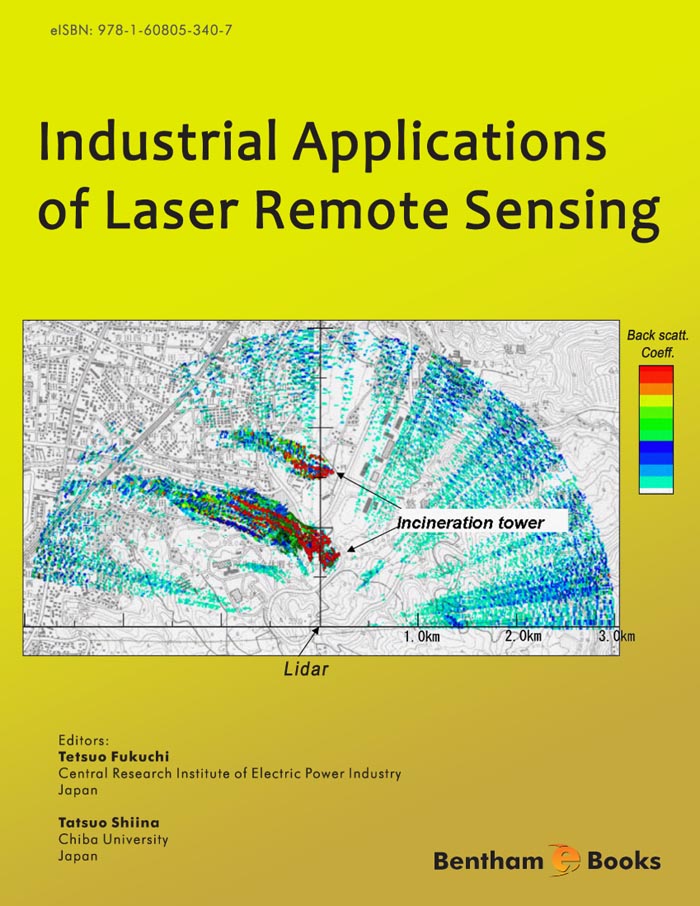This book covers industrial applications of laser remote sensing. Traditionally, laser remote sensing (lidar) has dealt with atmospheric measurement, with measurement ranges in the order of km. Therefore, lidar systems have been large in size and designed primarily for permanent installation and continuous measurement. However, for industrial applications, the system needs to be mobile or portable so that sensing could be performed at the necessary location at the necessary time, e.g. at regular servicing or maintenance, in case of accidents or malfunctions, at occasional environmental inspections.
There exist several books on laser remote sensing, e.g. R. Measures, Laser Remote Sensing (John Wiley, 1984), T. Fujii and T. Fukuchi, eds., Laser Remote Sensing (Dekker, 2005), C. Weitcamp, ed., Lidar: Range-Resolved Optical Remote Sensing of the Atmosphere (Springer, 2005). These books mainly cover atmospheric measurement. Recent lidar development has focused on satellite-borne lidar, whose aim is global monitoring of water vapor, ozone, CO2, wind, clouds, aerosols. On the other hand, a book on applications of laser remote sensing to closer ranges, in the order of m to tens of m, has not been previously published. These ranges require remote sensing because they are too large for in situ measurement using conventional sensors or sampling methods, but are too small for applying conventional lidar for atmospheric measurement.
Laser remote sensing has several potential industrial applications in these closer measurement ranges, such as leak gas detection, pollutant detection, environment monitoring, wind profiling, and structural health monitoring. This book aims to provide some specific applications which may be useful to industry, as well as other applications such as marine environment monitoring, vegetation monitoring, and minor constituent monitoring, which are more oriented toward science, but may have applications to industry in the future.
An overview of laser remote sensing and its applications to industry are presented in Chapter 1. Various kinds of lidar and measurable quantities are described.
Conventional lidar design intended for atmospheric measurement does not allow sensing at very close range, because of insufficient overlap between the transmitted laser beam and the receiver field of view. In order to overcome the problem of insufficient overlap, new concepts on lidar design are under development for near field applications. The design of an in-line type lidar is covered in Chapter 2.
Lasers have found increased use in industrial applications such as gas leak detection and pollutant detection. The most common technique used for gas leak detection is laser absorption spectroscopy, which is covered in Chapter 3. Another technique used for gas leak detection is Raman scattering, whose application to hydrogen gas leaks is covered in Chapter 4. Hydrogen is a gas species which cannot be detected by absorption, and this recently developed technology could find wide use with the increasing introduction of hydrogen energy. Pollutant detection using differential absorption lidar, e.g. measurement of gas species in stack emission, is briefly covered in Chapter 3.
Laser remote sensing has wide applications, which are not limited to detection of gases. The applications to the marine environment, such as bathymetry, oil spill detection, and water quality inspection are presented in Chapter 5. Application to vegetation monitoring is covered in Chapter 6. Laser-induced fluorescence from chrollophyl can provide useful information on vegetation growth.
Laser sensing has also found use in safety and security. Although the death rate due to traffic accidents is declining every year owing to safer vehicles and better infrastructure, traffic accidents still rank at the top of the causes of accidental deaths. An example of the application of laser radar to traffic safety is covered in Chapter 7.
The increase in use of renewable energy sources has led to a rapid increase in electricity generation using wind power. For optimal siting of windmills, profiling of local winds is necessary. The all-fiber laser Doppler lidar, which has recently been developed, has dramatically decreased the size and power consumption, so that portable wind profiling has become possible. This is covered in Chapter 8.
An important social issue is the safety of infrastructure such as bridges and tunnels. The use of conventional ultrasound techniques is labor intensive, as it requires contact between the sensor and the object under testing. The application of laser ultrasound provides non-contact testing with a standoff distance of several meters. Recent developments in this field and application to inspection of concrete structures such as railway tunnels are covered in Chapter 9.
Lastly, remote Laser-Induced Breakdown Spectroscopy (LIBS) for minute concentration detection is covered in Chapter 10. This method provides the equivalent of Atomic Emission (AE) spectroscopy in a remote configuration. Since no sampling is necessary, the technology could be useful for minute concentration detection in hazardous environments.
The affiliations of the authors of this book are distributed among academic institutions, private and government research institutes, and private companies. The distribution was chosen so that the content will vary from fundamental research to practical applications.
Although laser remote sensing is especially suited to plasmas and combustion fields because of its ability to perform non-contact measurement, the applications to these areas are not covered in this book, because comprehensive texts already exist. The interested reader is requested to refer to these texts, such as K. Muraoka and M. Maeda, Laser-Aided Diagnostics of Plasmas and Gases (Institute of Physics Press, 2001), A. Eckbreth, Laser Diagnostics for Combustion Temperature and Species (Taylor & Francis, 1996).
The editors hope that this book be a useful addition to the technical library of researchers and engineers interested in laser sensing and its applications.
Tetsuo Fukuchi
Central Research Institute of Electric Power Industry
Japan
Tatsuo Shiina
Chiba University
Japan

